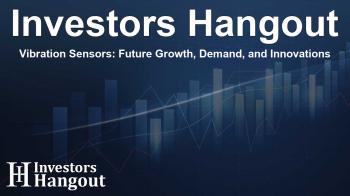Vibration Sensors: Future Growth, Demand, and Innovations

Vibration Sensors: Future Growth, Demand, and Innovations
The vibration sensor market is increasingly dynamic and anticipated to reach a notable value, enhancing its role in various industries. With a compounding growth rate leading up to a forecasted valuation, these sensors stand at the forefront of technological advancements. This article delves into the factors driving this momentum and the market landscape.
Understanding the Vibration Sensor Market Growth
According to market analysis, the vibration sensor industry is expected to witness remarkable growth. By the end of the forecast period, the value of this market could exceed USD 8.19 billion, reflecting a CAGR of 7.5%. This escalation is largely influenced by an upsurge in industries heavily reliant on predictive maintenance and enhanced automation.
Key Drivers of Growth
The demand for vibration sensors is prominently growing in sectors such as automotive, aerospace, healthcare, and manufacturing. These sensors facilitate effective monitoring of vibrations and shocks, which ensures machinery's operational health and promotes structural integrity.
Industry Applications and Trends
The automotive sector plays a crucial role, accounting for a significant 25% market share. Here, vibration sensors monitor engine performance, addressing potential issues before they escalate. Meanwhile, the aerospace and defense sectors are on an upward trajectory, consolidating their position as major contributors to market growth. The integration of these sensors in guidance systems and turbine engine monitoring further exemplifies their importance.
Technological Advances in Vibration Sensors
The market is also responding to technological evolution. Products like MEMS accelerometers are becoming central in applications ranging from industrial machines to consumer electronics. Notably, the accelerometer segment generated 41% of revenue, thanks to its essential role in motion-sensing technologies.
Geographical Analysis: Leading Regions
In terms of geographical potential, North America currently retains the largest share at roughly 35%. Its thriving industrial landscape, coupled with extensive use in sectors like automotive and aerospace, positions this region as a leader in the vibration sensor market. On the other hand, the Asia Pacific region is projected to experience the highest growth rate, driven by rapid automation developments and increased manufacturing activities across countries like China and India.
Market Players and Innovations
Leading companies in the vibration sensor arena include Baumer, Bosch Sensortec, TE Connectivity, and Honeywell International Inc., each contributing through diverse product offerings. For instance, Bosch Sensortec has launched ultra-compact MEMS accelerometers designed for energy-efficient applications in wearables, showcasing the innovation at play in this market.
Future Outlook for Vibration Sensors
The future of vibration sensors appears promising as industries expand their focus on predictive maintenance and automation to enhance operational efficiency. The growing reliance on these sensors signifies not only an expansion in market size but also a transformation in operational practices across various sectors.
Frequently Asked Questions
What is the current market value of the vibration sensor industry?
The vibration sensor market was valued at approximately USD 4.29 billion and is expected to reach USD 8.19 billion by the end of the forecast period.
What factors are driving the demand for vibration sensors?
The demand is driven by needs in predictive maintenance, automotive safety, and advancements in automation technologies.
Which industries are the largest consumers of vibration sensors?
Industries like automotive, aerospace, healthcare, and manufacturing utilize these sensors extensively for monitoring and maintenance.
Which region is expected to experience the highest growth in the vibration sensor market?
The Asia Pacific region is projected to experience the fastest growth due to increased automation and manufacturing expansion.
What are some emerging trends in the vibration sensor market?
Key trends include the development of compact MEMS accelerometers and the integration of AI for predictive maintenance applications.
About Investors Hangout
Investors Hangout is a leading online stock forum for financial discussion and learning, offering a wide range of free tools and resources. It draws in traders of all levels, who exchange market knowledge, investigate trading tactics, and keep an eye on industry developments in real time. Featuring financial articles, stock message boards, quotes, charts, company profiles, and live news updates. Through cooperative learning and a wealth of informational resources, it helps users from novices creating their first portfolios to experts honing their techniques. Join Investors Hangout today: https://investorshangout.com/
Disclaimer: The content of this article is solely for general informational purposes only; it does not represent legal, financial, or investment advice. Investors Hangout does not offer financial advice; the author is not a licensed financial advisor. Consult a qualified advisor before making any financial or investment decisions based on this article. The author's interpretation of publicly available data shapes the opinions presented here; as a result, they should not be taken as advice to purchase, sell, or hold any securities mentioned or any other investments. The author does not guarantee the accuracy, completeness, or timeliness of any material, providing it "as is." Information and market conditions may change; past performance is not indicative of future outcomes. If any of the material offered here is inaccurate, please contact us for corrections.
